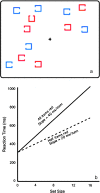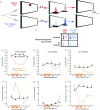CNTRICS final task selection: control of attention
- PMID: 19074499
- PMCID: PMC2617743
- DOI: 10.1093/schbul/sbn158
CNTRICS final task selection: control of attention
Abstract
The construct of attention has many facets that have been examined in human and animal research and in healthy and psychiatrically disordered conditions. The Cognitive Neuroscience Treatment Research to Improve Cognition in Schizophrenia (CNTRICS) group concluded that control of attention-the processes that guide selection of task-relevant inputs-is particularly impaired in schizophrenia and could profit from further work with refined measurement tools. Thus, nominations for cognitive tasks that provide discrete measures of control of attention were sought and were then evaluated at the third CNTRICS meeting for their promise for future use in treatment development. This article describes the 5 nominated measures and their strengths and weaknesses for cognitive neuroscience work relevant to treatment development. Two paradigms, Guided Search and the Distractor Condition Sustained Attention Task, were viewed as having the greatest immediate promise for development into tools for treatment research in schizophrenia and are described in more detail by their nominators.
Figures



Similar articles
-
Harnessing cognitive neuroscience to develop new treatments for improving cognition in schizophrenia: CNTRICS selected cognitive paradigms for animal models.Neurosci Biobehav Rev. 2013 Nov;37(9 Pt B):2087-91. doi: 10.1016/j.neubiorev.2013.09.011. Epub 2013 Sep 30. Neurosci Biobehav Rev. 2013. PMID: 24090823 Free PMC article.
-
CNTRICS final animal model task selection: control of attention.Neurosci Biobehav Rev. 2013 Nov;37(9 Pt B):2099-110. doi: 10.1016/j.neubiorev.2012.05.009. Epub 2012 Jun 6. Neurosci Biobehav Rev. 2013. PMID: 22683929 Free PMC article. Review.
-
Selecting paradigms from cognitive neuroscience for translation into use in clinical trials: proceedings of the third CNTRICS meeting.Schizophr Bull. 2009 Jan;35(1):109-14. doi: 10.1093/schbul/sbn163. Epub 2008 Nov 20. Schizophr Bull. 2009. PMID: 19023126 Free PMC article.
-
CNTRICS final task selection: executive control.Schizophr Bull. 2009 Jan;35(1):115-35. doi: 10.1093/schbul/sbn154. Epub 2008 Nov 14. Schizophr Bull. 2009. PMID: 19011235 Free PMC article. Review.
-
CNTRICS final task selection: working memory.Schizophr Bull. 2009 Jan;35(1):136-52. doi: 10.1093/schbul/sbn153. Epub 2008 Nov 5. Schizophr Bull. 2009. PMID: 18990711 Free PMC article. Review.
Cited by
-
Measuring reinforcement learning and motivation constructs in experimental animals: relevance to the negative symptoms of schizophrenia.Neurosci Biobehav Rev. 2013 Nov;37(9 Pt B):2149-65. doi: 10.1016/j.neubiorev.2013.08.007. Epub 2013 Aug 28. Neurosci Biobehav Rev. 2013. PMID: 23994273 Free PMC article. Review.
-
Decreased interhemispheric coordination in schizophrenia: a resting state fMRI study.Schizophr Res. 2012 Oct;141(1):1-7. doi: 10.1016/j.schres.2012.07.027. Epub 2012 Aug 19. Schizophr Res. 2012. PMID: 22910401 Free PMC article.
-
Impaired Fixation-Related Theta Modulation Predicts Reduced Visual Span and Guided Search Deficits in Schizophrenia.Cereb Cortex. 2020 May 14;30(5):2823-2833. doi: 10.1093/cercor/bhz277. Cereb Cortex. 2020. PMID: 32030407 Free PMC article.
-
Harnessing cognitive neuroscience to develop new treatments for improving cognition in schizophrenia: CNTRICS selected cognitive paradigms for animal models.Neurosci Biobehav Rev. 2013 Nov;37(9 Pt B):2087-91. doi: 10.1016/j.neubiorev.2013.09.011. Epub 2013 Sep 30. Neurosci Biobehav Rev. 2013. PMID: 24090823 Free PMC article.
-
Reverse translation of the rodent 5C-CPT reveals that the impaired attention of people with schizophrenia is similar to scopolamine-induced deficits in mice.Transl Psychiatry. 2013 Nov 12;3(11):e324. doi: 10.1038/tp.2013.82. Transl Psychiatry. 2013. PMID: 24217494 Free PMC article.
References
-
- Bleuler E. Dementia Praecox or the Group of Schizophrenias. New York, NY: International Universities Press; 1950.
-
- Kraepelin E. Dementia Praecox and Paraphrenia. Edinburgh, UK: E. & S. Livingston; 1919.
-
- Braff D. Information processing and attention dysfunctions in schizophrenia. Schizophr Bull. 1993;19:233–259. - PubMed
-
- Nuechterlein KH, Dawson ME. Information processing and attentional functioning in the developmental course of schizophrenic disorders. Schizophr Bull. 1984;10:160–203. - PubMed
-
- Cornblatt BA, Keilp JG. Impaired attention, genetics, and the pathophysiology of schizophrenia. Schizophr Bull. 1994;20:31–46. - PubMed
Publication types
MeSH terms
Grants and funding
- MH037705/MH/NIMH NIH HHS/United States
- R01 MH080332/MH/NIMH NIH HHS/United States
- MH065034/MH/NIMH NIH HHS/United States
- MH068580/MH/NIMH NIH HHS/United States
- R01 MH037705/MH/NIMH NIH HHS/United States
- P30 MH068580/MH/NIMH NIH HHS/United States
- K02 MH001072/MH/NIMH NIH HHS/United States
- P50 MH066286/MH/NIMH NIH HHS/United States
- R21 MH080426/MH/NIMH NIH HHS/United States
- MH080426/MH/NIMH NIH HHS/United States
- MH066286/MH/NIMH NIH HHS/United States
- MH080332/MH/NIMH NIH HHS/United States
- K02 MH01072/MH/NIMH NIH HHS/United States
- R01 MH065034/MH/NIMH NIH HHS/United States
LinkOut - more resources
Full Text Sources
Medical

